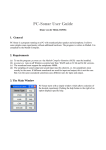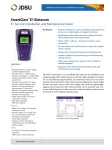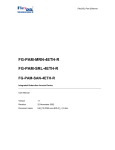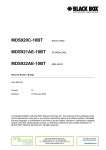Download Siemens ET1 Series Technical information
Transcript
TAINET MARS 9000 Trunk and DACS Module ET1 9011/ET2 9012 Operation Manual The Professional Partner TAINET COMMUNICATION SYSTEM CORP. Headquarters: Beijing Branch: No. 25, Alley 15, Lane 120, Sec. 1. Nei-Hu Rd., Taipei 114, Taiwan, R.O.C. TEL: 886-2-26583000 FAX: 886-2-26583232 3F, A Building, 113 Zhi Chun Lu, HaiDian District, Beijing, China Zip Code: 100086 Tel: 86-10-62522081~87 Fax: 86-10-62522077 V1.2 07008-00046 2004/03/24 Contents Chapter 1 INTRODUCTION 1.1 Functional Description ....................................................................... 1-2 1.2 Technical Information ........................................................................ 1-3 1.3 Hardware description ......................................................................... 1-4 Chapter 2 INSTALLATION 2.1 2.2 2.3 2.4 2.5 Unpacking .......................................................................................... 2-2 Installing ETx module........................................................................ 2-2 Configuring ETx parameters.............................................................. 2-3 Administrative Interface: LCD front panel ........................................ 2-4 ETx menu tree .................................................................................... 2-5 2.5.1 E1 CH SEL: Select E1 port for NMC 9000 operates............ 2-6 2.5.2 CONFIG E1: E1 main link parameters................................. 2-6 2.5.3 SYSTEM MANAGE: System level functions ..................... 2-8 2.5.4 DACS SET: Time slot interchange map.............................. 2-10 2.5.5 TEST: Loopback diagnostic functions .................................2-11 2.5.6 ALARM: Alarm indication functions.................................. 2-14 2.5.7 STATUS: System statistics functions .................................. 2-15 2.5.8 ERROR COUNT: Error count statistics............................. 2-17 Figure Figure 1-1 ET1/ET2 9011B/9012B............................................................................ 1-2 Figure 1-2 ET1/ET2 9011U/9012U ........................................................................... 1-2 Figure 1-3 ET1/ET2 9011E/9012E ............................................................................ 1-2 Figure 1-4 ET1 9012U Faceplate............................................................................... 1-4 Figure 2-1 Module installation................................................................................... 2-2 Figure 2-2 Organization of ETx menu tree ................................................................ 2-5 Figure 2-3 Local Data Loopback path.......................................................................2-11 Figure 2-4 Remote Data Loopback path ...................................................................2-11 Figure 2-5 Local Line Loopback path...................................................................... 2-12 Figure 2-6 Remote Line Loopback path .................................................................. 2-12 Table Table 1-1 Faceplate Connectors ................................................................................. 1-4 Table 1-2 Faceplate LED indicators........................................................................... 1-4 Table 2-1 ‘CONFIG E1’ group function .................................................................... 2-7 Table 2-2 Load Profile list.......................................................................................... 2-8 Table 2-3 SYSTEM MANAGE group function......................................................... 2-9 Table 2-4 TEST group function................................................................................ 2-13 Table 2-5 DACS SET group function ...................................................................... 2-14 Table 2-6 STATUS group function........................................................................... 2-16 Table 2-7 ERROR Count Object list ........................................................................ 2-17 Chapter 1 INTRODUCTION Overview 1.1 Functional Description 1.2 Technical Information 1.3 Hardware description 1-1 INTRODUCTION 1.1 Functional Description ETx 901x series are the aggregate link modules of MARS 9000 DSL CONCENTRATOR. They provide the functionality of interface between the system TDM bus and the E1 aggregate link. By utilizing this module, payload from IDSL, MSDSL, MDSL, HDSL, and data port modules is aggregated to backbone-network/hierarchy-ring for transportation and switching. Several models are provided for variety of applications: ET1 9011B:Single E1 port, Balanced mode G.703 interface (Mini terminal-block) ET1 9011U:Single E1 port, Unbalanced mode G.703 interface (BNC connector) ET1 9011E:Single E1 port, Unbalanced mode G.703 interface (Euro-style Siemens 1.6/5.6 connector) ET2 9012B:Dual E1 port, Balanced mode G.703 interface (Mini terminal-block) ET2 9012U:Dual E1 port, Unbalanced mode G.703 interface (BNC connector) ET2 9012E:Dual E1 port, Unbalanced mode G.703 interface (Euro-style Siemens 1.6/5.6 connector) ET1 ET1 ET2 SEL SEL SCAN SCAN 1 SYNC SEL SCAN 2 SYNC ET2 SEL SEL SEL SCAN SCAN SCAN 1 SYNC ET1 ET2 2 SYNC 1 SYNC ALM ALM ALM ALM ALM ALM TEST TEST TEST TEST TEST TEST AIS AIS AIS AIS AIS RX RX TX TX RX TX 2 SYNC AIS RX RX RX TX TX TX RX RX TX TX RX TX EXT CLK EXT CLK EXT CLK EXT CLK EXT CLK EXT CLK CRAFT CRAFT CRAFT CRAFT CRAFT CRAFT RST RST RST RST RST RST 9012U 9011E 9012E 9011B 9012B Figure 1-1 ET1/ET2 9011B/9012B 9011U Figure 1-2 ET1/ET2 9011U/9012U Figure 1-3 ET1/ET2 9011E/9012E Difference between models is the physical E1 interface (connector). They all provide the same functionality for MARS 9000 system, and running the same firmware code. We will use the name ETx to represent all these modules in following sentences, except for special distinction. 1-2 INTRODUCTION 1.2 Technical Information The E1 interface of ETx is fully comply with ITU-T recommendation G.703 and G.704. This module supports configurable CRC-4 option to enhance transmission integrity. E bit (Remote End Block Error bit) defined in ITU-T Rec. G.704 is also supported, helping carrier with an easier solution to monitor the E1 aggregate link. Physical interfaces of E1 links on ETx 901xU are unbalanced, 75-ohm resistance, terminated by female BNC connectors. ETx 901xB with balanced, 120-ohm resistance, terminated by mini terminal-blocks. ETx 901xE with unbalanced, 75-ohm resistance, terminated by Siemens 1.6/5.6 connectors. The ETx module is Hot Swappable, which minimizes system downtime by no power down insertion/replacement. Whenever there’s a need to re-initialize hardware, reset switch can be reached on faceplate. The MARS 9000 system is implemented with an in-built DACS (Digital Access Cross-connect System). It supports comprehensive and flexible cross-connect functionalities such as: Ø Ø Ø Ø Interchange time-slot between E1 ports on the same ETx module. Interchange time-slot between E1 ports and TDM buses. Interchange time-slot between TDM buses on the same system. Cross-connect between E1 ports and TDM buses (per 32 time-slot). It reduces the cost for buying more ports on external DACS and utilizes E1 trunks at highest efficiency by managing local cross-connect traffic. Due to the design of this in-built DACS function, no traffic can pass directly from one tributary to another. All the data from tributaries must be forwarded to TDM bus in order to be directed to the destination. The timing mode of ETx can be one of three options: Recover from E11, Generate internal clock and External clock. If more than one ETx modules are coexisting on one MARS9000 system, only one of them can be in Master2 mode and the others should be in Slave mode. An ETx in Master mode will be the timing source of entire MARS 9000 system, including TDM bus and all other tributaries. The other ETx in Slave mode will follow the clock from TDM bus. The timing clock feeding into EXT CLOCK connector must be G.703 unframed all ‘1’ signal and the acceptable accuracy is ±50 PPM (±5.0 x 10-5). *Note 1 2 Refer to Clk Source Sel in section 2.5.3 SYSTEM MANAGE for timing clock options Refer to Clk Source Mode in section 2.5.3 SYSTEM MANAGE for the necessary steps to setup an ETx in Master and Slave mode. 1-3 INTRODUCTION 1.3 Hardware description The ETx can be installed in any I/O slot (slot 1 to 16) of TRS-32M. The outlook and description of faceplate is shown below (ET1 9011U for example, refer to page 1 for outlook of other models): ET2 Connectors EXT CLK SCAN 1 Connector for E1 interface Inlet of external SYSTEM CLOCK (network clock) RJ-45 phone jack socket for connecting console terminal RS-232 characteristics TX / RX SEL 2 SYNC CRAFT ALM TEST AIS RX Table 1-1 Faceplate Connectors TX RX LED indicators SEL TX SCAN EXT CLK SYNC Selection indicator selected by LCD front panel Indicator of polling activity E1 synchronization status indicator ALM Alarm indicator TEST Test mode indicator AIS AIS indicator CRAFT RST 9012U Figure 1-4 ET1 9012U Faceplate 1-4 RED = Selected OFF = Not selected Blinking if polled by NMC-32 RED = Loss of Synchronization GREEN = Synchronized RED = Alarm detected (read section 2.5.4 for complete list of alarms) OFF = No active alarm YELLOW = Test on going (read section 2.5.3 for available test functions) OFF = Normal operational mode RED = AIS signal detected OFF = Normal operation Table 1-2 Faceplate LED indicators Chapter 2 INSTALLATION Overview 2.1 Unpacking 2.2 Installing ETx module 2.3 Configuring ETx parameters 2.4 Administrative Interface: LCD front panel 2.5 ETx menu tree 2.5.1 E1 CH SEL: Select E1 port for NMC 9000 operates 2.5.2 CONFIG E1: E1 main link parameters 2.5.3 SYSTEM MANAGE: System level functions 2.5.4 DACS SET: Time slot interchange map 2.5.5 TEST: Loopback diagnostic functions 2.5.6 ALARM: Alarm indication functions 2.5.7 STATUS: System statistics functions 2.5.8 ERROR COUNT: Error count statistics 2-1 INSTALLATION 2.1 Unpacking Keep the packing box and/or shock-absorb material after unpacking ETx modules. You may need them for safely shipping the module in the future. Rough handling during shipping may cause module failure upon arrival. After unpacking, check carefully for shipping damage. Contact the shipper if you notice any damage. 2.2 Installing ETx module The ETx module can be installed in any one of the TRS-32M slots. After it is installed, the MARS 9000 controller will find it and start the initialization process automatically. When inserting this module into TRS-32M, hold the card on two screw knobs and keep this card vertically to the floor (refer to the illustration below). Be sure to fit the upper and bottom edge of card right in the slide-in trail before insertion (it may crash the card if inserted without fitting in both trails). Slide this card smoothly into chassis along the trail until bus connectors firmly fit into chassis back plane. Double check if the card is inserted well then tighten the upper and bottom screws by hand (to prevent from breaking the screw, tighten by a screwdriver is not recommended). Turn on the power supply unit with NMC-32 installed. The SCAN LED on faceplate should start blinking in couple seconds. If it’s not blinking, please recheck the card is correctly fitted into slot and reinstall again if necessary. If the NO SCAN problem can’t be resolved or you have trouble installing the card, please contact with your local dealer for technical support. ETx TRS-32M Figure 2-1 Module installation 2-2 INSTALLATION 2.3 Configuring ETx parameters By default, ETx was preset to operate on CCS mode (PCM31) which may be the most common configuration for E1 connections. There are 4 factory profiles hard-coded in the system, each of them defines one type of commonly used E1 configuration (a table is provided in PROFILE group at section 2.5.3 SYSTEM MANAGE for selection). To successful setup E1 links on ETx module, all necessary parameters must be clear and confirmed. If you don’t know some of them, consult your network operator about the detail. In case the configuration need to be changed, two administrative interfaces are supported: l LCD front control panel of NMC 9000: 8 Full functional menu tree driven system. 8 2 x 16 character-LCD display with back light. 8 6 function buttons to switch between menu items and changing configurations. 8 For detailed operation instructions, please “Administrative interface: LCD front panel” read section 2.4 l Craft interface (Available soon) 8 Use a VT-100 or compatible emulator with communication parameters set to “Asynchronous, 8 data bit, None parity bit, 1 stop bit” to launch the craft user interface. 2-3 INSTALLATION 2.4 Administrative Interface: LCD front panel Control of ETx trunk card can be reached via LCD front panel of NMC 9000. This full-functional administrative interface provides you a feasible way to setup parameters without additional facilities (ex. connecting a VT-100 terminal). For detailed operational instructions, please refer to chapter ‘Introduction of LCD front panel’ of ‘MARS9000 base system’ manual. After ETx is selected on front panel, the brief state is reported on LCD. This window gives prompt information of current E1 timing clock setting and E1 link status as illustrated below: C1MCK-INT SYSTEM SYNC C1 CK-CH1 SYSTEM SYNC : : : Port 1 is the selected for control operations on NMC 9000 Current timing clock is Master and Internal mode Port 1 is synced with remote E1 equipment Press [ENTER] button will lead you to the start of ETx menu tree. This menu tree contains six groups, each provides specific configurable options or system statistics. Understand each of them will help you set up the system more quickly and is also required for designing a trouble-free network. Figure 1 shows the organization of entire menu tree. Detailed information for each group will be discussed later in section 2.5. 2-4 INSTALLATION 2.5 ETx menu tree Higher Level NMC Option Password Edit C1MCK-INT SYSTEM SYNC C1 MENU SELECT E1 CH SEL Lock Front Lock Unlock Initial System Are you sure? Input: _ _ _ _ 2: PCM31 1: PCM30C 20000119_1E1_2E1 S/W Ver:01.07 C1 MENU SELECT SYSTEM MANAGE Load Profile 0: PCM30 3: PCM31C Trunk Bank Sel CH 1,2,3,4 Clk Source Sel Clk Source Mode Ext Int Master Slave System Bus E1 Ch2 E1 Ch1 C1 MENU SELECT CONFIG E1 Shift Right EXIT ENTER Shift Left C1 MENU SELECT ERROR COUNT CRC ON/OFF Idle Code 0xff Idle Ch. Sel. D 24..31: ________ Idle Ch. Sel. C 16..23 : ________ Idle Ch. Sel. B 08..15 : ________ Idle Ch. Sel. A 00..07 : ________ Rx MODE CCS/CAS Tx MODE CCS/CAS E BIT AUTO/NONE ALARM GEN AIS/RALM/NONE E BIT COUNT Ext Clk Lost CRC4 ERROR Rx Dist MF Alarm Rx Unframed All 1s FAS ERROR C1 MENU SELECT ALARM Clear All Alarm Rx Lost of Sync Rx signaling All 1s It shows only if Alarm was happen C1 MENU SELECT TEST C1 MENU SELECT STATUS C1 MENU SELECT DACS SET Rx Remote Alarm Rx Carrier Lost System Error Rx signaling All 0s Data Loop ON/OFF Clear All Test Are you sure? TxSig All 1 ON/OFF TxUnf All 1 ON/OFF Remote LL ON/OFF Line Loop ON/OFF Remote DL ON/OFF Figure 2-2 Organization of ETx menu tree 2-5 INSTALLATION 2.5.1 E1 CH SEL: Select E1 port for NMC 9000 operates This menu select one of the available E1 ports for operations on NMC 9000 front panel. As this function only works on multiple E1 capable modules, this item takes no effect on model ET1. Configurable objects: E1 Channel 1: Select the first E1 port for the control operations on NMC 9000. E1 Channel 2: Select the second E1 port of ET2 card module for the control operations on NMC 9000. (Not available for model ET1) 2.5.2 CONFIG E1: E1 main link parameters Below are functional descriptions for all configurable objects in ‘CONFIG E1’ group. Refer to table 2-1 for all available options. Configurable objects: CRC: Turn on or off for CRC4 function. This option must be identical on both end of E1 link or the link will not work properly. ALARM GEN: Select the method to generate alarm signal to notice remote E1 equipment. Alarm signal will be generated if any of following three conditions present: 1. 2. 3. E BIT: ETx can not synchronize with remote from received frames. Receipt of AIS on E1 interface. (all ‘1’s) No signal detected on E1 interface. Switch on/off E bit function. E bit is the REBE bit defined as bit 1 of frame 13/15 in time slot 0, it is used to inform the remote system for local CRC error event. TX/RX MODE: Set E1 connection mode of TX/RX interfaces to CCS or CAS mode. The value for TX and RX must be identical to each other or the system will not work properly. Idle Ch. Sel. A/B/C/D : 2-6 Idle channel map for channel 0 to channel 31. Channels in Idle State will not be allowed to pass any data. INSTALLATION Object name CRC Available settings ON OFF (Default) AUTO ALARM GEN AIS Remote Alarm None(Default) AUTO E BIT NOT (Default) CCS (Default) CAS Tx Mode CCS (Default) CAS Rx Mode Idle Ch Sel A Displayed as: Idle Ch Sel B 00..07 ------Displayed as: 08..15 ------- Idle Ch Sel C Displayed as: 16..23 ------- Idle Ch Sel D Displayed as: Idle Code 24..31 ------0xff Description Enable CRC function. All outgoing traffic will be with CRC bits. Detected CRC error on incoming traffic will be reported to ‘CRC4 Error Count’ under ‘ERROR COUNT’ group. Disable CRC function. Auto detecting CRC4 pattern from received multiframes. This function detects CRC4 pattern only during E1 synchronizing phase. To apply this option during service, E1 link must be manually dropped for resynchronization. Send AIS to notice remote. (All ‘1’ signal) Set FAS distant alarm bit to inform remote system for local alarm. (This bit is the 3rd bit of NFAS in Time Slot 0, defined in G.703 specification) Do not generate any alarm. Enable REBE bits function. CRC must be enabled to have this option available. To enable CRC function: ‘CONFIG E1’->’CRC’->’ON’ Ignore REBE bits. Set Tx Mode to Common Channel Signaling mode. (PCM31) Set Tx Mode to Channel Associated Signaling mode. (PCM30) Set Rx Mode to Common Channel Signaling mode. (PCM31) Set Rx Mode to Channel Associated Signaling mode. (PCM30) ‘-‘ hyphen sign represent a channel is activated ‘*’ star sign represent a channel is forced idle Press [Enter] to switch the state ‘-‘ hyphen sign represent a channel is activated ‘*’ star sign represent a channel is forced idle Press [Enter] to switch the state ‘-‘ hyphen sign represent a channel is activated ‘*’ star sign represent a channel is forced idle Press [Enter] to switch the state Note:Ch.16 is reserved under CAS mode ‘-‘ hyphen sign represent a channel is activated ‘*’ star sign represent a channel is forced idle Press [Enter] to switch the state Current version support fixed 0xff idle code Table 2-1 ‘CONFIG E1’ group function 2-7 INSTALLATION 2.5.3 SYSTEM MANAGE: System level functions Below are functional descriptions for all system administration objects in this group. Refer to table 2-3 for all available options. Available objects: Load Profile: CLK SEL CRC ALARM GEN E BIT TX/RX MODE Idle Ch. A~D Idle Code Note: Reset system with pre-defined factory profiles. Detailed information for each profile is listed in table 2-2. Initial E1 OFF NONE NONE CCS 0:PCM30 E1 OFF NONE NONE CAS 1:PCM30C E1 ON NONE NONE CAS 2:PCM31 E1 OFF NONE NONE CCS 3:PCM31C E1 ON NONE NONE CCS 4: ~ 7: reserved reserved reserved reserved reserved NONE 0XFF NONE 0XFF NONE 0XFF NONE 0XFF NONE 0XFF Reserved Reserved 1.Load profile 0 through 3 or ‘Initial System’ will cause loss of user defined parameters. 2.Profile 4 to 7 are left blank and reserved for future use. Table 2-2 Load Profile list Initial System: Reset system and restore all configurable value to factory default. Make sure this action is necessary because all settings will be lost after command executed. Font Lock: When front panel is ‘Locked’, operations on buttons are still available for viewing statistics/settings. But changing any parameter is prohibited. Therefore, before making any changes, NMC 9000 must be in ‘Unlock’ state. By default, NMC 9000 front panel is locked. Password Edit: Change the administrator’s password. This password is used when unlocking front panel. Clk Source Mode: Select the timing mode between ETx and TDM bus. If Master mode selected, ETx will provide timing clock to entire MARS 9000 system (TDM bus). If Slave mode selected, ETx will follow the clock from TDM bus. Only one Master is acceptable in one MARS 9000 platform. Clk Source Sel: 2-8 Select the timing source of ETx. INSTALLATION Trunk Bank Sel: Select the TDM bank to transport ETx traffic. Only one out of two banks (4 * 32 time-slot bus) can be chosen for each ETx module. Object name Available settings Load Profile 0: PCM30 Description Default E1 settings for CAS(PCM30) mode 1: PCM30C Default E1 settings for CAS(PCM30) mode with CRC option enabled 2: PCM31 Default E1 settings for CCS(PCM31) mode 3: PCM31C Default E1 settings for CCS(PCM31) mode with CRC option enabled Initial System Are you sure? Reinitialize system to factory default (CCS mode). All user defined parameters will be changed. [ENTER]=’Yes’, [EXIT]=’No’ Front Lock Lock Lock front panel to prevent from unauthorized changes on configuration Unlock Unlock front panel. Password is required to release the lock. Password Edit Input : ---- Clk Source Mode Clk Source Sel Trunk Bank Sel E1 Connect Sel Step 1: Input administrative password for authentication Edit : ---- Step 2: Enter new password Verify : ---- Step 3: Re-enter new password again for verification Master Set the module as the clock source of MARS 9000 system Slave Follow timing clock from TDM bus E1 Ch1 Recover clock from 1st E1 port E1 Ch2 Recover clock from 2nd E1 port System Bus Follow timing clock from TDM bus Int Generate clock signal Ext Follow clock signal from EXT CLK interface Ch 1,2,3,4 Select bank 1 (TDM bus 1~4) as transport medium. Ch 5,6,7,8 Select bank 2 (TDM bus 5~8) as transport medium. Refer to instruction above Table 2-3 SYSTEM MANAGE group function 2-9 INSTALLATION 2.5.4 DACS SET: Time slot interchange map This group contains all time slot interchange mapping information of all E1s and TDM bus on the same ETx. Each entry of this map contains following four items: Available objects: Source time slot Target time slot State Command ‘Source time slot’ is expressed as: EPn:xx, where n is the E1 port number, xx is the time-slot number of E1. Or TDn:xx, where n is the TDM bus number, xx is the time-slot number of TDM bus. ‘Target time slot’ is expressed as: EPn:xx, where n is the E1 port number, xx is the time-slot number of E1. Or TDn:xx, where n is the TDM bus number, xx is the time-slot number of TDM bus ‘State’ is expressed as: D*/ß C*/ß Disconnect (disabled entry/disconnect target and source) Connect (effective entry/connect target and source) ‘Command’ is the action to execute current setting. Valid commands are: Do not apply the change (pressing [ENTER] with this symbol will not apply any change of the entry) ß Apply this entry (this symbol will show only during front panel operation. After the entry is applied, this symbol will return to ‘*’ as normal state) Example: * Cross-connecting between time slot 05 of the 1st E1 and time slot 13 of the 2nd E1: EP1:05 EP2:13 Cß Disable an entry: EP2:30 TD2:15 Dß Cross-connecting between time slot 10 of the 1st E1 and time slot 25 of TDM bus 6: EP1:10 TD6:25 Cß *Note: If the assigned time slot in a new entry is occupied by other entries, the controller will notice operator by displaying ‘Error Setting’, and no changes will be applied. 2-10 INSTALLATION 2.5.5 TEST: Loopback diagnostic functions Below are functional descriptions for all available loopback objects in ‘TEST’ group. Refer to table 2-4 for all available options. Configurable objects: Data Loop: Loopback digital data path within framer in the direction toward TDM bus. E1 TDM bus Transceiver end Framer end Loopback path Figure 2-3 Local Data Loopback path Remote DL: Loopback digital data path within framer in the direction toward E1 interface. E1 TDM bus Transceiver end Framer end Loopback path Figure 2-4 Remote Data Loopback path 2-11 INSTALLATION Line Loop: Loopback analog path within transceiver in the direction toward TDM bus. E1 TDM bus Transceiver end Framer end Loopback path Figure 2-5 Local Line Loopback path Remote LL: Loopback analog path within transceiver in the direction toward E1 interface. E1 TDM bus Transceiver end Framer end Loopback path Figure 2-6 Remote Line Loopback path Tx Unframed All 1s: Transmit constant all 1 signal on E1 interface for testing. Tx Signaling All 1s: Transmit all 1 on time slot 16 frames for testing. Clear All Test: 2-12 Clear all active test and return to normal operational mode. INSTALLATION Object name Available settings Data Loop Remote DL Line Loop Remote LL TxUnf All 1 TxSig All 1 Description On Force data loop for local testing Off Cancel Data Loop On Force data loop for remote testing Off Cancel Remote Data Loop On Force line loop for local testing Off Cancel Line Loop On Force line loop for remote testing Off Cancel Remote Line Loop On Transmit constant all 1 signal on E1 interface Off Cancel this test On Transmit constant all 1 signal on E1 time slot 16 Off Cancel this test Clear All Test Table 2-4 TEST group function 2-13 INSTALLATION 2.5.6 ALARM: Alarm indication functions This group is hot popping and triggered by occurrence of alarm. If no active alarm presents, this group will become invisible from menu tree. Objects shown in this group are active alarms. This group contains only one user operational option as ‘Clear All Alarm’ which will clear all alarms history and start display new alarm. Below are functional descriptions for all alarm indication objects in ‘ALARM’ group. Some of the alarm will only occur under CAS mode, and they will be mentioned in the description. Alarm indication objects: Object name Description Rx signaling All 1s Receipt of All ‘1’s on time slot 16 under CAS mode. This usually indicates transmission trouble. Rx signaling All 0s Receipt of All ‘0’s on time slot 16 under CAS mode. This usually indicates transmission trouble. Ext Clk Lost Absence of EXT CLOCK signal. Rx Dist MF Alarm Remote SYNC LOSS indicator. This alarm will only occur under CAS mode. Rx unframed All 1s Receipt of AIS on E1 interface. Rx Remote Alarm Remote alarm indicator. This alarm occurs when one of following three condition presents on remote E1 equipment: 1. Can not synchronize with local ETx from received frames. 2. Receipt of AIS on E1 interface. (all ‘1’s) 3. No signal detected on E1 interface. Rx Carrier Loss Absence of Rx signal Rx Lost of Sync Local SYNC LOSS indicator. System Error ETx module failure indicator. Clear All Alarm Clear all alarm history. Table 2-5 DACS SET group function 2-14 INSTALLATION 2.5.7 STATUS: System statistics functions This group provides administrator a quick system status overview. Some of the objects are E1 link status and the others are most important E1 related configurations set in specific group. Table 2-6 lists all objects and their possible messages. System statistics objects: SYNC = : Synchronization status of ETx E1 interface. CLK SEL: ETx clock source selection. Refer to ‘CONFIG E1’ group for detailed information. CRC SET: Active setting of CRC option. Refer to ‘CONFIG E1’ group. Alarm Gen: Active setting of alarm generation options. Refer to ‘CONFIG E1’ group. E BIT: Active setting of E Bit treatment. Refer to ‘CONFIG E1’ group. Tx/Rx Mode: Active E1 link type of Tx/Rx interface. Refer to ‘CONFIG E1’ group. 2-15 INSTALLATION Object name SYNC = CLK SEL CRC Set Alarm Gen Available Message Description SYSTEM SYNC E1 trunk is synchronized with remote system NO CARRIER No signal detected on E1 interface FAS LOSS Loss of frame alignment. This indicates E1 link error and is reported when trunk card received incorrect Frame Alignment Signal. CAS LOSS Failed to synchronize with remote system on signaling (time slot 16) channel under CAS mode. This indicates an error on E1 link. CRC LOSS CRC error detected on received data. This will only occur when CRC option is enabled. When CRC LOSS occurs, E1 link could still work with lower accuracy, depend on the real error rate. E1 Follow recovered clock from E1. ‘CONFIG E1’->‘CLK SEL’->‘E1’ INT Generate timing clock with internal oscillator. ‘CONFIG E1’->‘CLK SEL’->‘INT’ EXT Follow external clock from EXT CLOCK connector ‘CONFIG E1’->‘CLK SEL’->‘EXT’ ON CRC4 function enabled ‘CONFIG E1’->’CRC’->’ON’ OFF CRC4 function disabled ‘CONFIG E1’->’CRC’->’OFF’ AUTO CRC4 semi-auto function enabled ‘CONFIG E1’->’CRC’->’AUTO’ NONE ‘CONFIG E1’->’Alarm Gen’->’None’ AIS ‘CONFIG E1’->’Alarm Gen’->’AIS’ Remote Alarm ‘CONFIG E1’->’Alarm Gen’->’RALM’ E Bit Tx Mode Rx Mode NONE ‘CONFIG E1’->’E BIT’->’None’ Auto ‘CONFIG E1’->’E BIT’->’Auto’ CCS ‘CONFIG E1’->’Tx Mode’->’CCS’ (PCM31) CAS ‘CONFIG E1’->’Tx Mode’->’CAS’ CM30) CCS ‘CONFIG E1’->’Rx Mode’->’CCS’ (PCM31) CAS ‘CONFIG E1’->’Rx Mode’->’CAS’ CM30) Table 2-6 STATUS group function 2-16 INSTALLATION 2.5.8 ERROR COUNT: Error count statistics Errors count objects: This group provides administrator a reference to detected transmission error counts. This error-count objects will count the statistic error during one second, and is restarted every second. Table 2-7 lists all objects. CRC4 Error Count: Counter that counts detected CRC4 errors. This counter will restart at every second and will stop counting during E1 SYNC LOSS. E Bit Count: Counter that reports the received E Bits from remote equipment. This counter will restart at every second and will stop counting during E1 SYNC LOSS. FAS Error Count: Counter that counts Frame Alignment Signal error words. This counter will restart at every second. Object name Description CRC4 Error Count Detected CRC4 errors per second. Len. 10 E Bit Count Received E Bit count per second. 10 FAS Error Count Detected FAS error counts per second on received frames. 12 Len. : Size of counter in bits. Table 2-7 ERROR Count Object list 2-17 INSTALLATION This page is intentionally left blank. 2-18


































